
11 minute read
SOLUTIONS IN PRACTICE: Real life essentials in five-minute case studies: Aircraft Performance Monitoring at Wizz Air
ALTERNATIVELY…
The alternative might look something like figure 7.
Figure 6
Statistics demonstrate that strategy is often confused, miscommunicated and not well executed by the airline industry. While that’s a bold statement, there are plenty of examples if anyone wants to ask. Imagine, though, a future where the industry provides high-level strategic leadership about operational nuance from which airlines can draw; delivering a lot of that non-proprietary, non-competitive stuff that Marcus discussed.
Picture a suite of tools, exchange standards, data sharing and collaborative capability that enables the industry to support operational strategies and outcomes, and reduce the bottlenecks, delays and scarcity issues that we were all grumbling about not so long ago. Imagine the same tools supporting airline operational strategies, improving the integration of departmental processes and data within the airline and, crucially, with new partners in the likely wave of mergers and global alliances that COVID will produce. Picture too, that airlines can draw from a library of industry-based leadership, data, information and knowledge, easing the repetitive, extensive and expensive turnover of knowledge acquisition and capability replicated by every airline in precisely the same way, over and over again. Airlines would return knowledge to the industry in a symbiotic connection that frees it of scarcity driven efficiency drains and delivers more of the lowhanging efficiencies most think are gone… except they’re not.
Remarkably, all this capability exists, and airlines could benefit from it today. What doesn’t exist is the collective will and leadership to bring it together. This could be a profoundly beneficial program that could reset IATA. Hello, Mr Walsh? Recursive rework reinventing wheels Fragmentation over cohesion Perception over strategy Industry-wide digitisation and digitalisation at risk The status-quo The Do Nothing Option





Remember these?
Figure 7
We all want to get back in the sky as soon as possible. There’s no doubt it is the highest priority for airlines, but we think how that is done will be crucial, lest the industry jumps straight from the colloquial ‘frying pan into the fire’. Remember the other issues constraining industry efficiency from part one?
So far, it seems perception management remains the focus for the road out of COVID, not the critical strategic outcomes required to rebuild the industry into a more robust, agile and resilient version of itself. Figure 7 represents the status quo. In project management, we call this the ‘do nothing option’. While it’s a legitimate and proper project tool, we have to decide as an industry when we contemplate looking back from 2029 whether ‘do nothing’ was in the industry’s best interests.
We do a lot well, but there are some things we don’t. A lot of this discussion is
about the strategic maturity of the industry and its airlines. The collective contentment with the status quo comprehensively demonstrates that we’ve got some way to go. In the context of figure 8.1, strategic maturity is where an airline might rate itself on a strategy and system maturity scale, something like figure 8.1…
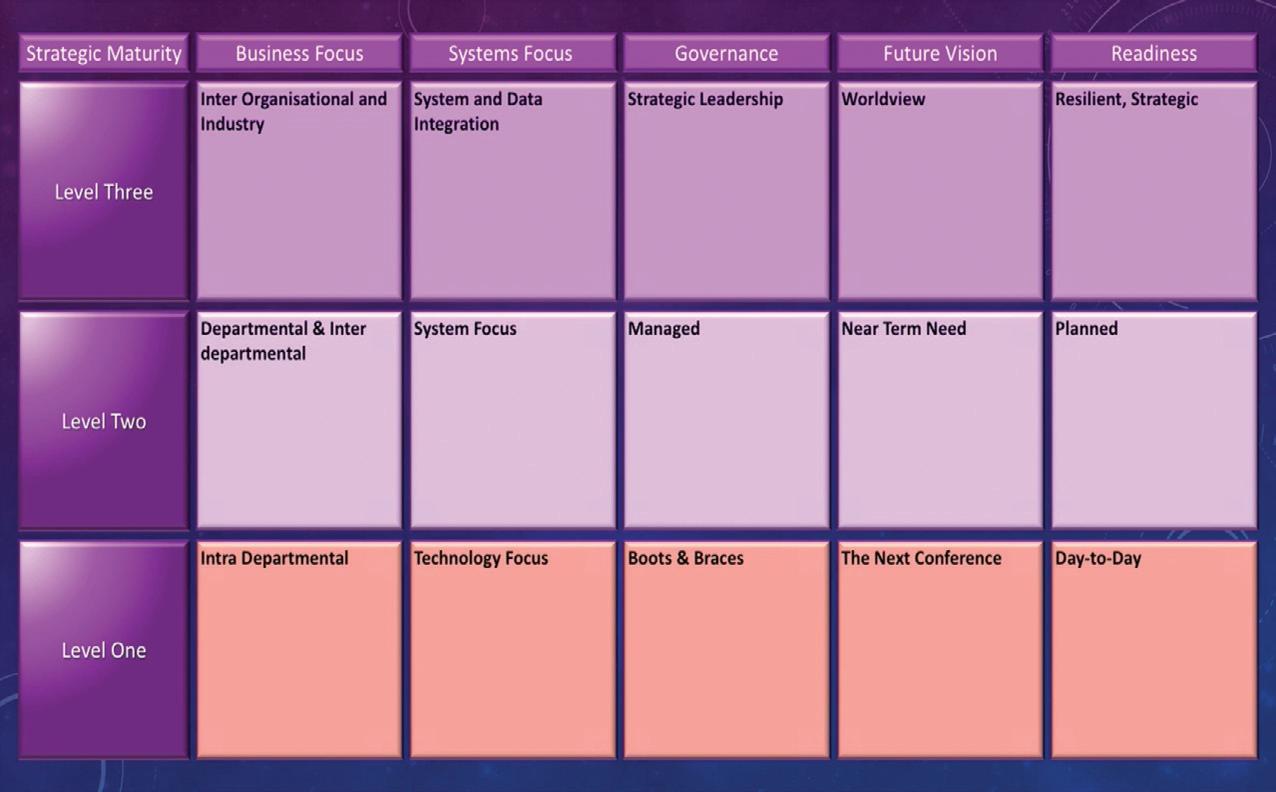
Figure 8.1
… weighing key metrics against its operational and business attitudes. At Closed Loop, we use a matrix like this with our clients at the beginning of most projects. Airlines audit almost everything in the operational space. Why not the entire organization’s capability and readiness for change? We’ve included possible headings here, but these are typically client and project-dependent; no doubt, each reader’s will be different. Check the tiles that represent your degree of strategic maturity.
Drilling into a couple (figure 8.2), Closed Loop has written about the industry’s focus on technology and how reliance on technology as the panacea for everything is a handbrake on real efficiency. We know that there will be those who want to debate that point, but we have the models to demonstrate it, and we’ve talked about them since 2009. Our work with airlines to help them invert the technology perspective triangle demonstrates it to customers very quickly. Here’s what a lot of the industry looks like.
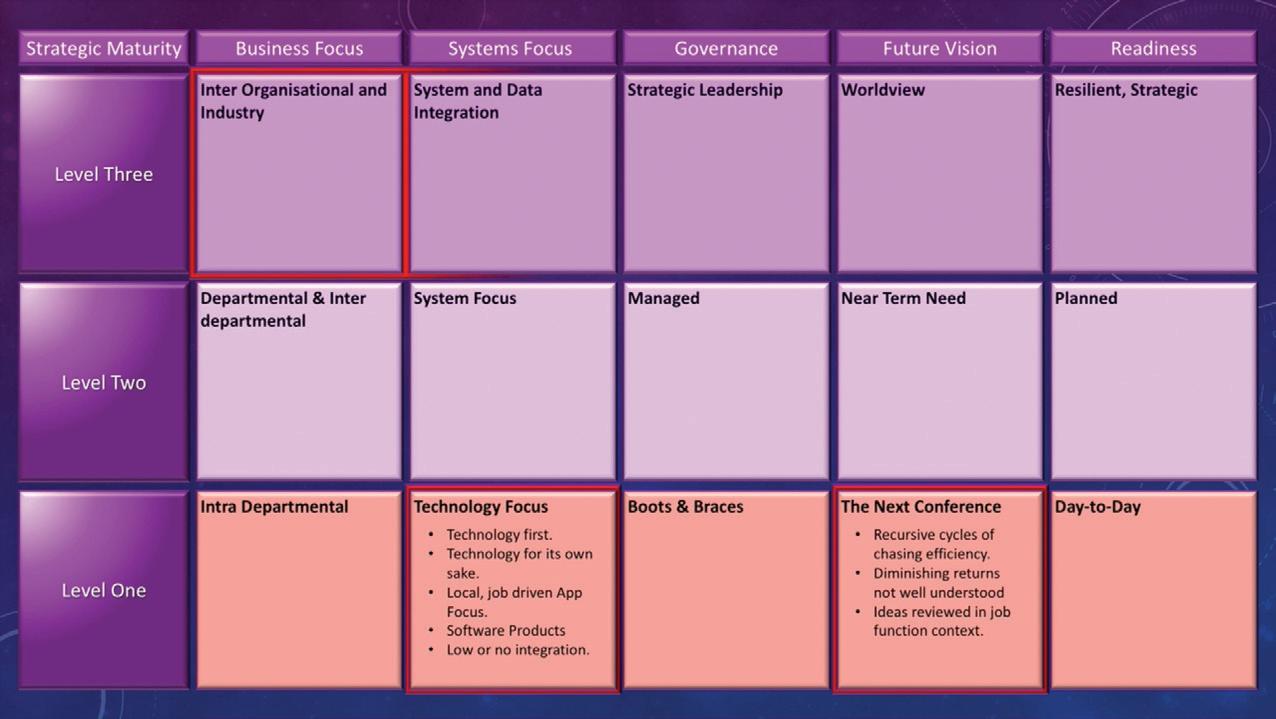
Figure 8.2
Focusing on level one, the ‘technology first, business second and ‘system’ somewhere down the road, if at all,’ emphasis of projects habitually disregards the business ‘system’ aspects in which the technology must reside. Rather than technology as an enabler of next-level capability; system, processes, or procedures often become constrained by it. It’s not that there’s anything wrong with particular technology; it’s usually the result of incomplete rationale, a lack of attention to the real problem. The lack of integration at this level is pivotal: the industry has a pressing need to deliver collaborative outcomes across the sector and the entire journey supply chain. The future will be data-driven and integrated, yet many of our technologies remain closed. The IATA Webinar, ‘Adapt and Grow’ on May 26, 2020, comprehensively discussed this as a significant industry dilemma. Data integration will be crucial to the solution, but how many are doing it? How many know what it really is? Suppliers are not at fault: we said in a recent blog that, in the absence of a lead from their customer base, Suppliers will develop what they
think we need, and they do that really well, so well, in fact, that it’s why the airlines tie their future vision to the next conference.
Conferences, like those organized by Aircraft Commerce, AircraftIT and others, provide instant gratification, seeing and touching the latest gadgets. Because it’s new every time, some airlines take years to figure out what they’re actually looking for. We’ve discussed the two-decade machinations some went through in their search for the EFB in previous articles. The struggle had nothing to do with technology; there were many capable EFB systems to choose from. The issue was the business case, and the difficulty with that emanated from a lack of systems thinking and future vision. The big problem with the current manner in which these things are approached is that without a plan, the increasing tempo of technology makes the sweet spot for a gadget ever shorter. So, focusing on technology alone becomes an ever recursive and ever-diminishing cycle. A tool like the maturity matrix illuminates the current state of an organization. It identifies the aspirational pathways needed to develop to the future state and the steps necessary to achieve them; it also helps drag thinking out of technology alone to a more infinite worldview — instead of what we think we need by this coming Friday.
A UNIFIED INDUSTRY
Stepping outside the cave and getting started on strategic objectives and plans for emergence from COVID and beyond isn’t a massive investment in monetary terms but one of will and leadership. “Leadership needs to come from the front; it needs to be strategic, planned, coordinated and facilitated. It needs to be from an advocate of the industry for the industry: not politicians or regulators.”
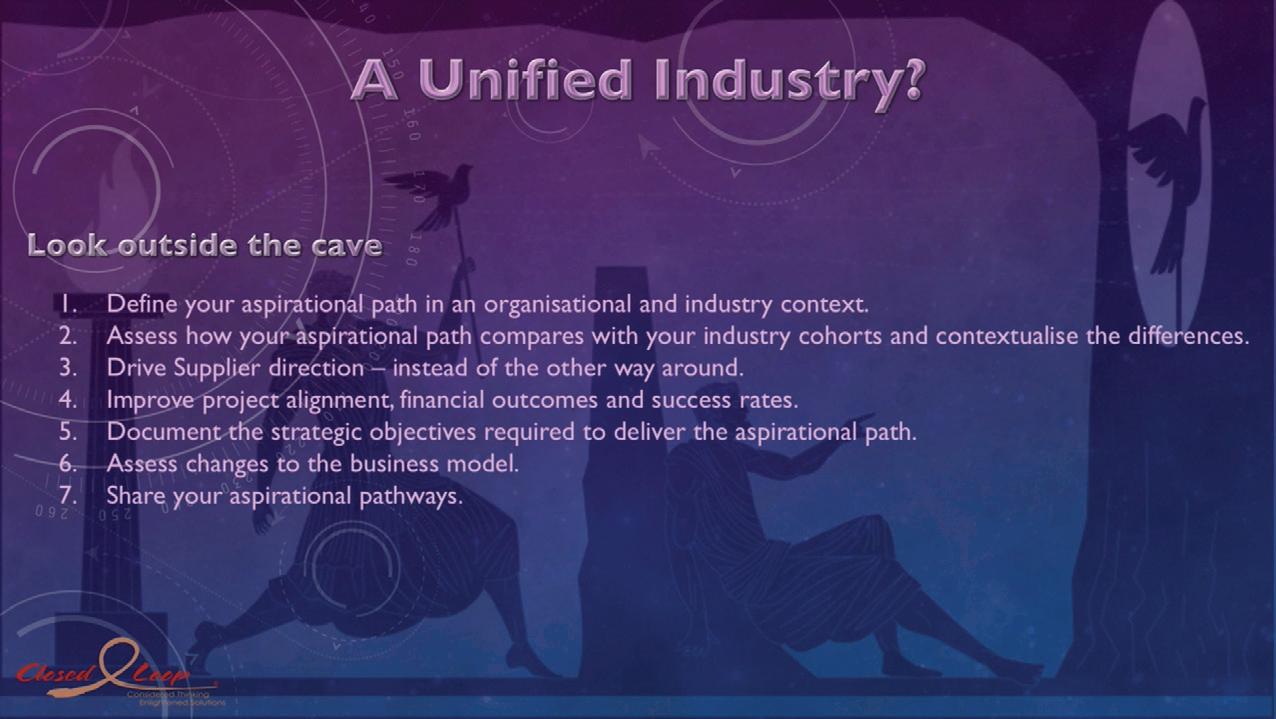
Airlines must look to the future instead of backwards to the past. They must choose now how 2019 and 2020 will be seen from some future vantage point. In 2029, traffic levels will have re-established, at least from COVID-19 and likely resumed the trajectory that created the obstacles in 2019. Depending on what we take from this pandemic, we may be better prepared next time. Will we be leveraging data and collaboration to combat the issues that we face, those issues that put a handbrake on our ability to operate efficiently and deliver other critical aspirations like our environmental stewardship? Or will the industry be a copy of the same, doing the same things we’ve always done but expecting a different outcome? As we plan our path out of COVID, getting planes in the air is but one aspect. It’s time to reimagine how we do many of the things we do and decide how they fit the industry we ‘see’ in 2029.
Leadership needs to come from the front; it needs to be strategic, planned, coordinated and facilitated. It needs to be from an advocate of the industry for the industry: not politicians or regulators. It needs to be ready with strategies and plans to guide airlines in planning and implementing the future. This gig belongs to IATA, and it’s up to airlines to tell them so. Here’s the perfect platform for IATA’s new leadership to reenergize the organization.
For our industry, context is king, so to set some context, here’s a bit about us to close the article.
CLOSED LOOP
As important as what we do is why we do it. At the core of Closed Loop is our belief that a unified industry operating with a unified future-focused worldview about the issues facing it and the capability to consistently deliver change successfully is crucial to its strength, resilience and growth. Our core belief is supporting the industry to achieve a new worldview and helping airlines and the airline industry along that aspirational trajectory. We’re supported by a great team (figure 10); we have the people, experience and specifically developed methodologies that deliver success every time. All this stands behind the services we provide.
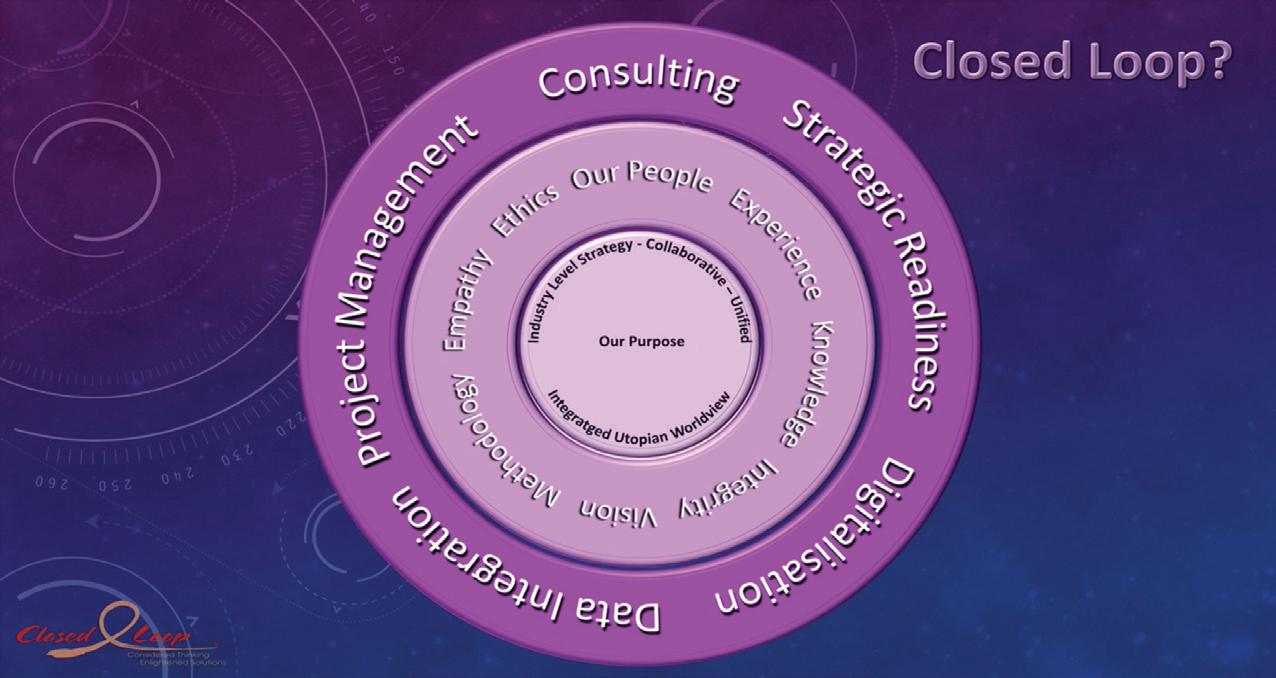
Figure 10
In figure 11, we’ve highlighted a few of the projects we’ve helped our customers with over the eleven years we’ve been together. If it’s not there, the chances are that no one’s asked for it yet.
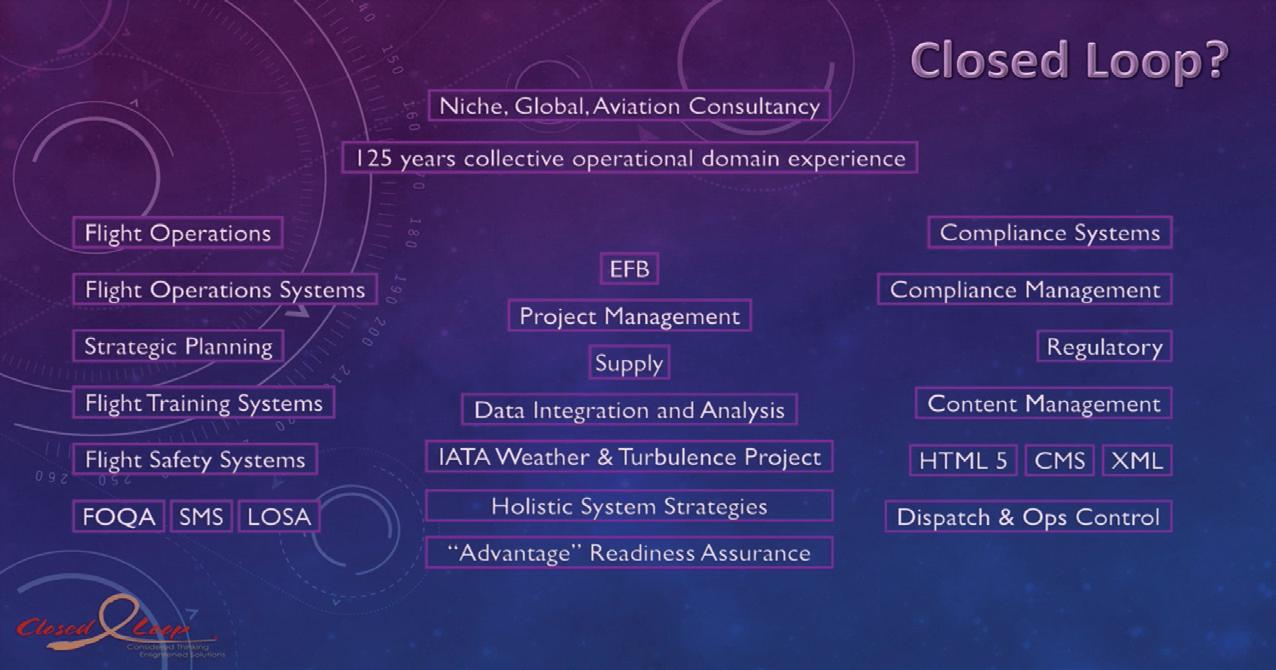
Figure 11
We’ve been involved in quite a bit over our time together, and the experience gives us insight into how the industry has developed and, we think, some freedom to discuss how it might develop into the future. We definitely believe a discussion about the future is about as crucial as it can get. If you’d like have any of the points raised in this article explained in more detail than the space here allows, please feel free to contact us.
MICHAEL BRYAN
Michael has enjoyed an Aviation Career spanning over 45 years. Recently retired from an A380 Command with a major carrier, he holds a Master of Aviation Management, a business degree in strategic planning and is a certified PRINCE2™ practitioner. He has experience in Airline, Corporate and General Aviation operations including training, system development, project and management positions. Michael’s management experience has included Strategic Planning and operational system development and Project Management across all industry segments. He is the founding Principal and Managing Director of Closed Loop Consulting.
MARCUS CARR
In his twenty years at Allette Systems, Marcus delivered projects dealing with complex data sets covering civilian and military aviation, legislation, mortgage lending, telecommunications, drug and medical data, case law, technology and almost everything in between. Clients include Qantas, the Department of Defence, KBR, Telstra, the Department of Health and Ageing, The Australian Tax Office, LIXI, Butterworth’s, CCH, AusDI and dozens of others. Knowledge of data systems has been fundamental to Marcus’ success in project management. He has been the longtime editor of a set of standards produced by LIXI and adopted by the whole of the lending industry in Australia. He has also spoken at numerous conferences, particularly dealing with the delivery of critical data sets in time-critical projects. Marcus holds the position of Director of Projects within the Closed Loop Group. He is a PRINCE2® Practitioner and a firm believer that project management is a human task, not a software function.
MARTIN MITEV
Martin has worked in the aviation industry since 2010. He has held many titles until today, of which ‘airline pilot’ and ‘aviation futurist’ for the longest. He has helped develop airline IT systems and advised flight operations management, flying planes and researching predictions all the while. His passion for aviation runs much deeper — since he first touched the controls of an aircraft at age six. That motivates his, sometimes contrarian, insights which he freely shares, hopefully for the benefit of all.
CLOSED LOOP
Closed Loop is a global team of aviation professionals supporting industry and airline management, and their people, to deliver strategically crucial, business-driven, financially sustainable and assured transformation outcomes. The business specialises in assisting airlines and other stakeholders to manage and deliver the coming wave of industry change and to integrate that with airline strategic and efficiency program portfolios; providing support, guidance or direction through all levels of the airline — from the Board to the tarmac and into the aircraft.
INTERACTIVE GIVE US YOUR OPINION
CLICK HERE TO POST YOUR COMMENT
INTERACTIVE SUBSCRIBE HERE
CLICK HERE TO READ ALL FUTURE EDITIONS




